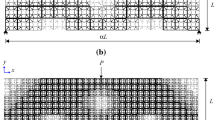Abstract
Design of functionally graded material (FGM), in which the mechanical property varies along one direction, is the focus of this study. It is assumed that the microstructure of the FGM is composed of a series of base cells in the variation direction and self-repeated in other directions. Bi-directional evolutionary structural optimization technique in the form of inverse homogenization is used for the design of the FGM for specified variation in bulk or shear modulus. Instead of designing a series of base cells simultaneously, the base cells are optimized progressively by considering three base cells at each stage. Thus, the proper connections between adjacent base cells can be achieved with high computational efficiency. Numerical examples demonstrate the effectiveness of the proposed method for designing microstructures of 2D and 3D FGMs with specified variation in bulk or shear modulus. The proposed algorithm can also be easily extended to design FGMs with other functional properties.











Similar content being viewed by others
References
Mattheck C, Bethge K (1998) Naturwissenschaften 85(1):1. doi:10.1007/s001140050443
Sarkar P, Bosneaga E, Auer M (2009) J Exp Bot 60(13):3615. doi:10.1093/jxb/erp245
Vincent JF (1999) J Exp Biol 202(23):3263
Koizumi M (1997) Composites Part B 28(1–2):1. doi:10.1016/s1359-8368(96)00016-9
Hirai T, Chen L (1999) Mater Sci Forum 308–311:509–514. doi:10.4028/www.scientific.net/MSF.308-311.509
Taylor D (2007) J Mater Sci 42:8911. doi:10.1007/s10853-007-1698-3
Lakes R (1993) Nature 361:511
Ichikawa K (2001) Functionally graded materials in the 21st century. Kluwer, Boston
Markworth AJ, Ramesh KS, Parks WP (1995) J Mater Sci 30(9):2183. doi:10.1007/bf01184560
Birman V, Byrd LW (2007) Appl Mech Rev 60(5):195. doi:10.1115/1.2777164
Zhou S, Li Q (2008) J Mater Sci 43(15):5157. doi:10.1007/s10853-008-2722-y
Sigmund O (1994) Int J Solids and Struct 31(17):2313. doi:10.1016/0020-7683(94)90154-6
Sigmund O (1995) Mech Mater 20(4):351. doi:10.1016/0167-6636(94)00069-7
Bendsøe MP, Sigmund O (2003) Topology optimization: theory, methods and applications. Springer, Berlin
Lin C-Y, Hsiao C-C, Chen P-Q, Hollister SJ (2004) Spine 29(16):1747
Chen K-Z, Feng X-A (2004) Comput Aided Des 36(1):51. doi:10.1016/s0010-4485(03)00077-0
Huang X, Xie YM (2007) Finite Elem in Anal Des 43(14):1039. doi:10.1016/j.finel.2007.06.006
Huang X, Xie YM (2010) Evolutionary topology optimization of continuum structures: methods and applications. Wiley, Chichester
Xie YM, Steven GP (1993) Comput Struct 49(5):885. doi:10.1016/0045-7949(93)90035-c
Xie YM, Steven GP (1997) Evolutionary structural optimization. Springer, London
Huang X, Radman A, Xie YM (2011) Comput Mater Sci 50(6):1861. doi:10.1016/j.commatsci.2011.01.030
Huang X, Xie Y, Jia B, Li Q, Zhou S (2012) Struct Multidiscip Optim. doi:10.1007/s00158-012-0766-8
Zhou S, Li Q (2008) Mater Lett 62:4022. doi:10.1016/j.matlet.2008.05.058
Wang MY, Zhou S, Ding H (2004) Struct Multidiscip Optim 28(4):262. doi:10.1007/s00158-004-0436-6
Aubert G, Kornprobst P (2006) Mathematical problems in image processing: partial differential equations and the calculus of variations. Springer, New York
Hassani B, Hinton E (1998) Comput Struct 69(6):707. doi:10.1016/s0045-7949(98)00131-x
Hassani B, Hinton E (1998) Comput Struct 69(6):719. doi:10.1016/s0045-7949(98)00132-1
Rozvany GIN, Zhou M, Birker T (1992) Struct Multidiscip Optim 4(3):250. doi:10.1007/bf01742754
Haug EJ, Choi KK, Komkov V (1986) Design sensitivity analysis of structural systems. Academic Press, Orlando
Author information
Authors and Affiliations
Corresponding author
Rights and permissions
About this article
Cite this article
Radman, A., Huang, X. & Xie, Y.M. Topology optimization of functionally graded cellular materials. J Mater Sci 48, 1503–1510 (2013). https://doi.org/10.1007/s10853-012-6905-1
Received:
Accepted:
Published:
Issue Date:
DOI: https://doi.org/10.1007/s10853-012-6905-1




